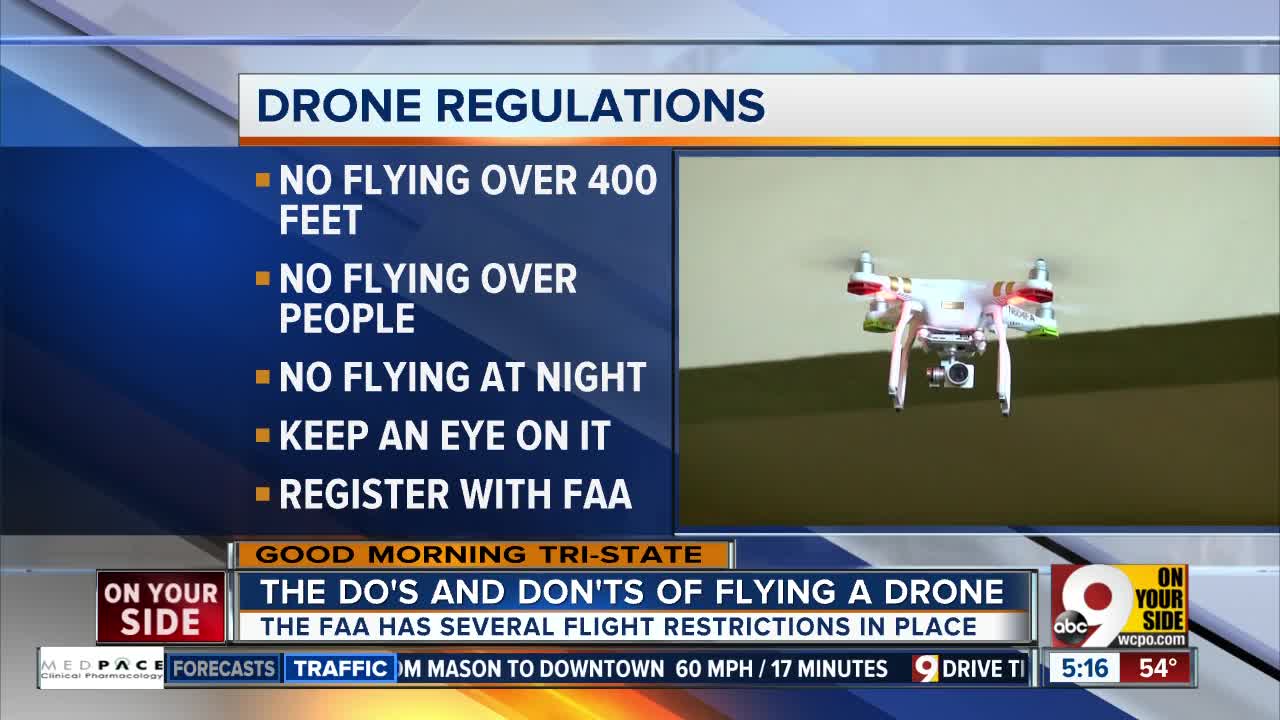HIGHLAND HEIGHTS, Ky. -- When Noah Vaniglia took his DJI Phantom 3 Professional drone up over Northern Kentucky University last fall he was immediately approached by students and asked a flurry of questions about what he was doing and what exactly was he flying.
Dan Nadler, VP of student affairs, said there is not a campus policy on drone usage.
“There is no university-wide drone policy,” Nadler told The Northerner in an email. “Should there be a need to use a drone, requests will be made on a case by case basis.”
RELATED: WCPO debuts Sky 9 quadcopter to tell stories from a bird's-eye view
“It’s a wild west right now,” said Vaniglia, sophomore electronic media broadcasting major. “I just wanted to fly on campus and take some aerial pictures. A lot of people want to come up and see what they are when you’re flying.”
Vaniglia bought his $1,200 drone a year ago after saving money from various videos he was making.
“I immediately started using it for establishing shots in my wedding edits and highlights,” Vaniglia said. “Then I started using it for other things like at Crossroads Church where I was a volunteer at the time.
Vaniglia’s drone shoots video in 4K, which is twice as many pixels as full high definition, and 12 megapixels for photos. The drone also sends a live feed to his iPad Mini.
When Vaniglia first got his drone he started to read about people getting in trouble with the Federal Aviation Administration.
“I wasn’t too nervous, but I was skeptical,” Vaniglia said. “Can I fly here? I was a little careful but not really.”
When Vaniglia initially got the drone, he would fly it right over Cincinnati to get video footage before the FAA cracked down on drone rules.
“I knew they were going to start putting laws where you can’t fly in the city because Chicago did it right away,” Vaniglia said.
The FAA regulations state that drones are not allowed to be flown more than 400 feet in the air, cannot go more than 100 miles per hour, must be visible by the operator at all times, can’t fly over people who aren’t operating the device, and may not be flown within five miles of an airport.
“It’s actually pretty restrictive in this area if you think about all of the smaller airports that exist,” said Aaron Zlatkin, NKU’s equipment manager.
On Aug. 29, the FAA implemented new rules for commercial drones. The new rule, called Part 107, allows drone operators to fly for commercial purposes after passing a test and getting a license.
“To actually get to fly commercially prior to this Part 107 thing you actually had to get an actual pilot license,” Vaniglia said.
Vaniglia said that the new test covers normal aviation information like wind speeds, but there isn’t a whole lot of information out about what the test covers.
“I don’t want to pay $150 and then fail it, so I’m trying to get as much information from who has already taken it,” Vaniglia said. “ I’ve got one friend who just got commercially certified the day you were allowed to, and he said the test was pretty difficult.”
Even with new policies and rules in place there are some areas that have banned drones from being flown there altogether.
NKU has a DJI Phantom 2 drone, but they haven't allowed students to rent it out yet.
“Honestly because of all those different legal and moral issues we haven’t officially added it to our inventory for checkouts,” Zlatkin said. “We’ve had some faculty check it out to get comfortable with the controls, but it doesn’t go out for regular use for class projects.”
Zlatkin said the ultimate goal is to allow students to check the drone out and get comfortable operating it, but students would have to go through a rigorous training program before getting to use it.
“It would involve not only how to operate the drone but also all of the legal background so we know that when they fly it, they can location scout and find a suitable location for it,” Zlatkin said.
Flint Wenstrup, sophomore electronic media broadcasting major, owns a DJI Phantom 3 Advanced drone, which he bought after using cheaper drones and getting used to flying them.
Wenstrup said he actually has avoided campuses and more urban areas because of the potential dangers.
Like Vaniglia, Wenstrup also gets asked a lot of questions when flying his drone.
“It’s really just a fascination of enjoyment and entertainment more than anything,” Wenstrup said.
Wenstrup said although he is confident in his drone operating abilities, he knows the devices need to be watched closely when they are in the air.
“I think personally I’m pretty confident in the drone and how I can fly,” Wenstrup said. “There are cases where I know someone who was flying it and it was a good 400ft away from him and it completely cut power and it dropped.
“Of course, it can be dangerous. It’s an unmanned object flying through the air and these things can go thousands of feet.That’s something to really be monitored.”
Cole Grecco is a journalism student at Northern Kentucky University. This article was originally published in The Northerner, NKU’s student newspaper and website.



